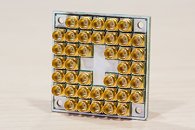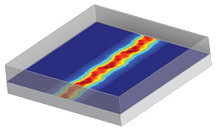
Intel Delivers 17-qubit Superconducting Chip with Advanced Packaging to QuTech
Today, Intel announced the delivery of a 17-qubit superconducting test chip for quantum computing to QuTech, Intel's quantum research partner in the Netherlands. The new chip was fabricated by Intel and features a unique design to achieve improved yield and performance. The delivery of this chip demonstrates the fast progress Intel and QuTech are making in researching and developing a working quantum computing system. It also underscores the importance of material science and semiconductor manufacturing in realizing the promise of quantum computing.
Quantum computing, in essence, is the ultimate in parallel computing, with the potential to tackle problems conventional computers can't handle. For example, quantum computers may simulate nature to advance research in chemistry, materials science and molecular modeling - like helping to create a new catalyst to sequester carbon dioxide, or create a room temperature superconductor or discover new drugs. However, despite much experimental progress and speculation, there are inherent challenges to building viable, large-scale quantum systems that produce accurate outputs. Making qubits (the building blocks of quantum computing) uniform and stable is one such obstacle.
Quantum computing, in essence, is the ultimate in parallel computing, with the potential to tackle problems conventional computers can't handle. For example, quantum computers may simulate nature to advance research in chemistry, materials science and molecular modeling - like helping to create a new catalyst to sequester carbon dioxide, or create a room temperature superconductor or discover new drugs. However, despite much experimental progress and speculation, there are inherent challenges to building viable, large-scale quantum systems that produce accurate outputs. Making qubits (the building blocks of quantum computing) uniform and stable is one such obstacle.

